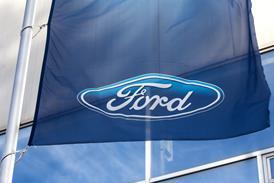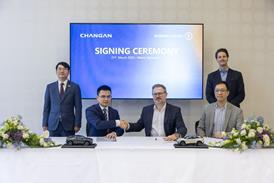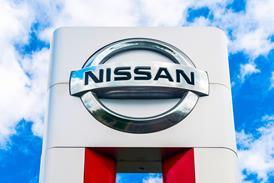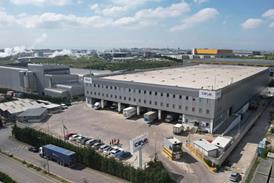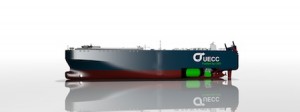 European short-sea operator UECC has ordered two pure car and truck carriers (PCTCs) to add to its 23-vessel fleet that are capable of being powered by both liquefied natural gas (LNG) along with heavy fuel or marine gas oil. The contract for the dual fuel new builds has been signed with Kawasaki Heavy Industries (KHI) for delivery in the second half of 2016. They will be built at NACKS shipyard in Nantong, China and have been jointly developed with KHI, UECC, Wallenius Marine and NYK Technical Group.
European short-sea operator UECC has ordered two pure car and truck carriers (PCTCs) to add to its 23-vessel fleet that are capable of being powered by both liquefied natural gas (LNG) along with heavy fuel or marine gas oil. The contract for the dual fuel new builds has been signed with Kawasaki Heavy Industries (KHI) for delivery in the second half of 2016. They will be built at NACKS shipyard in Nantong, China and have been jointly developed with KHI, UECC, Wallenius Marine and NYK Technical Group.
The vessels will be able to carry approximately 3,800 standard sized cars spread over 10 decks, as well as being able to carry significant loads of high and heavy cargo.
Both the vessels will be 1A super Finnish/Swedish ice class and able complete a 14 day round voyage in the Baltic using solely LNG fuel, including main engine and auxiliary power generation.
“The LNG installation is a pioneering design and will be one of the largest employed on a commercial vessel and the largest yet of its kind on a pure car and truck carrier,” said Glenn Edvardsen, CEO of UECC. “We are proud of the exciting step UECC is taking towards greener and more environmentally friendly shipping
The move comes ahead of European regulations being introduced at the beginning of next year restricting the sulphur content of bunker fuel to 0.1% in the Baltic and North Seas and the English Channel. LNG significantly reduces CO2 and nitrogen oxide (NO2) emissions, as well as almost eliminating sulphur oxide (SOx) and particulate emissions. It is being looked at as a long term solution to moving cargo through the sulphur emission control areas (SECAs) proposed by the International Maritime Commission, though UECC is also looking at other strategies given the short time before the regulations come into effect.
Finding a way to deal with the regulations is more pressing for UECC because it is one of the operators with high exposure to the SECA ruling. Five of the company’s 23 vessels spend 25% of their time in those waters, seven spend about 50-60% of their time there, and the remaining six 100% of their operating time.
What the latest order also indicates is that UECC is moving toward employing fewer but larger vessels on its routes in Europe in the interests of operating more efficiently, much as the container industry has done, a point verified by the company’s head of Car Transport Sales, Bjorn Svenningsen:
“We have no choice as we need to remain competitive,” he told Automotive Logistics. “Our costs are increasing; most of them cost elements that we cannot control and therefore we need to achieve economy of scale.”
UECC currently transports around 1.5m car equivalent units annually as well as operating several vehicle terminals in major European ports.










